 Wolves have mystified and awed people for centuries. They have been featured in myths and legends across many cultures. This week we are showing them a little extra love as we howl for Wolf Awareness Week! We wanted to take a closer look at why wolves are so important to our environment and what we can do to help them.
Wolves have mystified and awed people for centuries. They have been featured in myths and legends across many cultures. This week we are showing them a little extra love as we howl for Wolf Awareness Week! We wanted to take a closer look at why wolves are so important to our environment and what we can do to help them.
Wolves are a keystone species… but ok, what does that mean? Being a keystone species means that your habitat relies on you for helping maintain balance and that if you were removed from that habitat, it would drastically change. For example, when wolf populations began to decline and disappear in Yellowstone, a domino affect was initiated that affected many different species of animals and plants living there. But wolves are carnivores; how could they possibly affect the plants in their habitat if they don’t eat them?
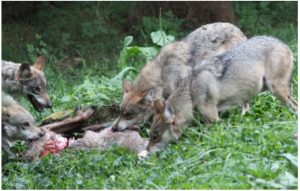 In Yellowstone, wolves are an apex predator, which basically means that they are at the top of the food chain. Some of their main food sources are elk and deer. Without wolves there to hunt them and keep population sizes in check, elk and deer quickly overpopulated Yellowstone. Higher population levels meant that there were more mouths to feed. That domino led then to a decline in willow and aspen populations in Yellowstone. The affect didn’t stop there, however. With less willow and aspen trees, songbirds began to experience population decline, and beavers were not able to build their dams, which led to more stream erosion. These dominos then led to a rise in water temperatures because of less dams and less tree shade, which led to a decrease in cold water fish populations.
In Yellowstone, wolves are an apex predator, which basically means that they are at the top of the food chain. Some of their main food sources are elk and deer. Without wolves there to hunt them and keep population sizes in check, elk and deer quickly overpopulated Yellowstone. Higher population levels meant that there were more mouths to feed. That domino led then to a decline in willow and aspen populations in Yellowstone. The affect didn’t stop there, however. With less willow and aspen trees, songbirds began to experience population decline, and beavers were not able to build their dams, which led to more stream erosion. These dominos then led to a rise in water temperatures because of less dams and less tree shade, which led to a decrease in cold water fish populations.
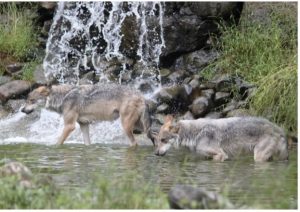 It almost seems unbelievable that all these changes happened just because the wolves were gone, but it’s moments like these that show us just how important it is to protect the animals, the plants, and the earth we share with them. In this case, wolves disappearing from Yellowstone was directly caused by human intervention. Wolves were seen as threats to livestock by farmers and threats to elk and deer populations living in the park, so it was decided that wolves needed to be removed. Over 136 wolves were killed between 1914 and 1926, and by the 1970’s, no wolves were found in Yellowstone.
It almost seems unbelievable that all these changes happened just because the wolves were gone, but it’s moments like these that show us just how important it is to protect the animals, the plants, and the earth we share with them. In this case, wolves disappearing from Yellowstone was directly caused by human intervention. Wolves were seen as threats to livestock by farmers and threats to elk and deer populations living in the park, so it was decided that wolves needed to be removed. Over 136 wolves were killed between 1914 and 1926, and by the 1970’s, no wolves were found in Yellowstone.
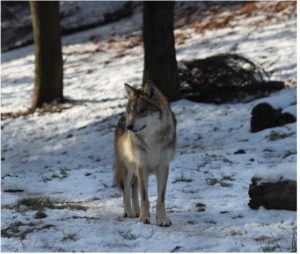 Thankfully, people across the United States have banded together to help save this beautiful ecosystem and restore its biodiversity and also to help bring wolves back from the brink of extinction. In 1995, the process began of introducing wolves back into Yellowstone. There have been ups and downs since then, but it is still exciting to have wolves back in Yellowstone and to see the land there beginning to recover.
Thankfully, people across the United States have banded together to help save this beautiful ecosystem and restore its biodiversity and also to help bring wolves back from the brink of extinction. In 1995, the process began of introducing wolves back into Yellowstone. There have been ups and downs since then, but it is still exciting to have wolves back in Yellowstone and to see the land there beginning to recover.
Passionate people caring about animals and doing what they can to help them is the only way we are going to be able to help preserve incredible animals like our wolves and the ecosystems they are part of. There are many easy ways that you can make a difference in their lives today! One important way is by making changes at home like reducing waste and recycling. This helps improve the environment we share with these animals and can help protect resources we share with them. Another way is by following legislature being voted on and letting your politicians know that protecting animals and the land they live on is important to you. Vote for politicians that support your viewpoints and will support topics that are meaningful to you.
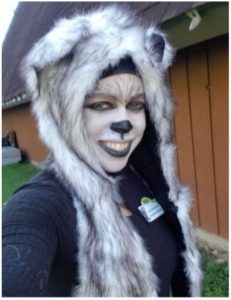 One additional way is by supporting organizations that provide care to wolves, do research on them, or help with breeding and reintroduction. These organizations often rely on donations to help them provide the animal care or education programs that they provide. The Lehigh Valley Zoo supports several wolf conservation groups including: the Wood River Wolf Project, the Wolf Conservation Center, and the Endangered Wolf Center. To help us with providing care for our wolves, you can symbolically ADOPT one of our wolves through our website. Every ADOPT An Animal Includes: a plush animal, a personalized Certificate of Adoption, a photo of your adopted animal, a Fact Sheet with information about your animal, two (2) child admission tickets or one (1) adult admission ticket to the Zoo. Make your howl for wolf conservation heard today by choosing how you will support wolf conservation!
One additional way is by supporting organizations that provide care to wolves, do research on them, or help with breeding and reintroduction. These organizations often rely on donations to help them provide the animal care or education programs that they provide. The Lehigh Valley Zoo supports several wolf conservation groups including: the Wood River Wolf Project, the Wolf Conservation Center, and the Endangered Wolf Center. To help us with providing care for our wolves, you can symbolically ADOPT one of our wolves through our website. Every ADOPT An Animal Includes: a plush animal, a personalized Certificate of Adoption, a photo of your adopted animal, a Fact Sheet with information about your animal, two (2) child admission tickets or one (1) adult admission ticket to the Zoo. Make your howl for wolf conservation heard today by choosing how you will support wolf conservation!
Written by Tara Mlodzienski
Education Specialist
Lehigh Valley Zoo | Schnecksville, PA
Sources:
Photo Credit: Volunteer Nancy


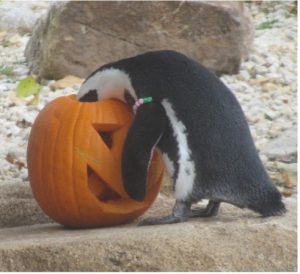 A slight chill blows in the air, and soon the smell of pumpkin spice follows right behind it. Once we start sipping our pumpkin spice lattes, we usually start dreaming about how we want to carve or decorate this year’s pumpkin to proudly display on our front porch. But did you know that carving and decorating pumpkins every year contributes to millions of pumpkins worldwide being added to landfills? When our jack-o-lanterns stop looking like jack-o-lanterns, our first instinct is to just throw them in the trash, but this adds to landfill waste and actually causes more methane production, which is a greenhouse gas 20 times more damaging than carbon dioxide.
A slight chill blows in the air, and soon the smell of pumpkin spice follows right behind it. Once we start sipping our pumpkin spice lattes, we usually start dreaming about how we want to carve or decorate this year’s pumpkin to proudly display on our front porch. But did you know that carving and decorating pumpkins every year contributes to millions of pumpkins worldwide being added to landfills? When our jack-o-lanterns stop looking like jack-o-lanterns, our first instinct is to just throw them in the trash, but this adds to landfill waste and actually causes more methane production, which is a greenhouse gas 20 times more damaging than carbon dioxide.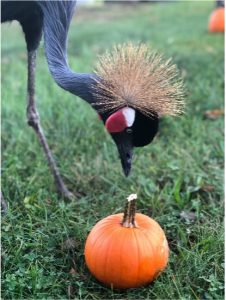 There is good news, however! There are still ways to have your pumpkin carving party but to make it a zero-waste activity. The first step is finding the perfect pumpkin. The best way to help reduce your carbon footprint here is by purchasing from local farmers or even by growing pumpkins in your very own backyard. Buying local produce means that it hasn’t travelled thousands of miles to get to you and thus hasn’t used as many fossil fuels. Local farmers are also more likely to grow organic products and not use as many pesticides. Plus it can be a lot of fun! Many local pumpkin patches now have family-friendly activities like hay rides or corn mazes. They often also sell delicious, homemade treats like apple cider doughnuts and pumpkin pie. So be sure to check out what kinds of pumpkin patches are in your area!
There is good news, however! There are still ways to have your pumpkin carving party but to make it a zero-waste activity. The first step is finding the perfect pumpkin. The best way to help reduce your carbon footprint here is by purchasing from local farmers or even by growing pumpkins in your very own backyard. Buying local produce means that it hasn’t travelled thousands of miles to get to you and thus hasn’t used as many fossil fuels. Local farmers are also more likely to grow organic products and not use as many pesticides. Plus it can be a lot of fun! Many local pumpkin patches now have family-friendly activities like hay rides or corn mazes. They often also sell delicious, homemade treats like apple cider doughnuts and pumpkin pie. So be sure to check out what kinds of pumpkin patches are in your area!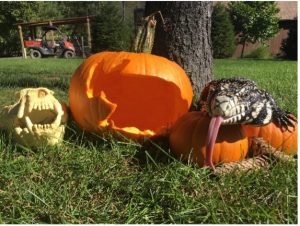 The next step is deciding if you want to carve or decorate. If you choose to decorate your pumpkin, be crafty and use decorations that can be removed. Decorations, including paint, cannot be put in compost bins (we’ll talk more about this in just a moment), so make sure everything can be removed when you want to dispose of your pumpkin. If carving is the way you want to go, save the parts you might normally throw away, like the seeds, guts, and any parts you cut out. Why should we save these, do you ask? Because you can eat them! You can make a wide variety of sweet or savory treats, including roasted pumpkin seeds, pumpkin puree (which leads to an incredible amount of options), and even pumpkin soup!
The next step is deciding if you want to carve or decorate. If you choose to decorate your pumpkin, be crafty and use decorations that can be removed. Decorations, including paint, cannot be put in compost bins (we’ll talk more about this in just a moment), so make sure everything can be removed when you want to dispose of your pumpkin. If carving is the way you want to go, save the parts you might normally throw away, like the seeds, guts, and any parts you cut out. Why should we save these, do you ask? Because you can eat them! You can make a wide variety of sweet or savory treats, including roasted pumpkin seeds, pumpkin puree (which leads to an incredible amount of options), and even pumpkin soup!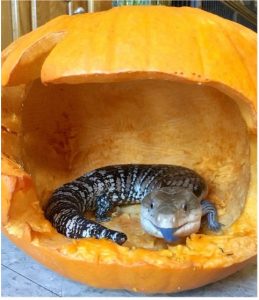 Whether you carve a masterpiece or decorate an incredible showpiece, eventually your pumpkin is going to start to look a little less than ideal. So what do you do with it now? About 30% of our trash is food scraps and yard waste. So instead of throwing it in the trash, try composting! If you love to garden, adding compost to your soil can actually help make your soil more nutritional for plants and can even help improve water quality. Even if you live in an apartment, there are easy ways to compost at home. If you can’t make a compost pile outside, you can purchase a small compost bin to keep indoors. Check out this website to learn more about composting and for tips and tricks to help you become a pro in no time:
Whether you carve a masterpiece or decorate an incredible showpiece, eventually your pumpkin is going to start to look a little less than ideal. So what do you do with it now? About 30% of our trash is food scraps and yard waste. So instead of throwing it in the trash, try composting! If you love to garden, adding compost to your soil can actually help make your soil more nutritional for plants and can even help improve water quality. Even if you live in an apartment, there are easy ways to compost at home. If you can’t make a compost pile outside, you can purchase a small compost bin to keep indoors. Check out this website to learn more about composting and for tips and tricks to help you become a pro in no time: 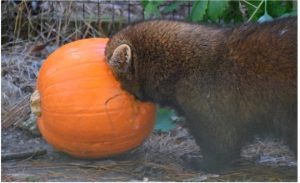 Don’t get your head stuck in a pumpkin this season over how to make the most of your pumpkin carving traditions this year. As you can see, there are many different, simple ways you can help make this pumpkin carving season a little greener (and a little tastier). Now get those carving tools ready, pick out your pumpkin, and be sure to stop by the Lehigh Valley Zoo if you’re looking for some carving inspiration!
Don’t get your head stuck in a pumpkin this season over how to make the most of your pumpkin carving traditions this year. As you can see, there are many different, simple ways you can help make this pumpkin carving season a little greener (and a little tastier). Now get those carving tools ready, pick out your pumpkin, and be sure to stop by the Lehigh Valley Zoo if you’re looking for some carving inspiration!